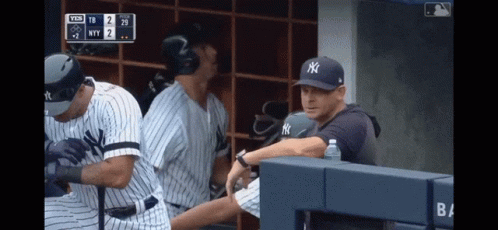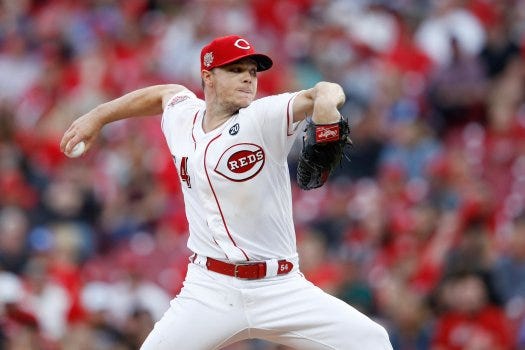Minority Report: Knowing the scouting language
When you follow minor league prospects, scouting reports are the primary source of information. For even the experienced fan, some of the lingo can be confusing. What is an “inverted W” and why is it important? A 50 is a failing score in school, but what does it mean for Alexander Vizcaino’s slider?
Today we will discuss some scouting jargon and help you understand what it means when someone calls Jasson Dominguez “toolsy.” You will almost definitely know some of them, may not have heard of others, and I even included one or two because they are funny. This list is by no means exhaustive and feel free to add some more in the comments.
Without further ado...
Tools, five-tool player, toolsy
Tools are the skillsets needed to be a successful major league player. For a position player, they are hitting for average, power, speed, defense, arm. A five-tool player is someone who is above average in all five. Toolsy is shorthand. Estevan Florial is considered a toolsy player.
Pitching tools are arm strength, velocity and movement of fastball, secondary pitches, and a combined score for long term health, mechanics, and demeanor on the mound.
Raw
A sharp tool, but not refined. Estevan Florial is one of the fastest in the organization but only has a 62% stolen base success rate. He is raw in that regard.
Scouting Scale
This is probably the most important. It is an attempt to give an objective score to a prospect’s talent. It can include ratings for each of a player's five tools and an overall score.
The span is between 20-80. Twenty indicates the tool is among the worst in MLB, 80 is the best, and 50 is average.
20: Again, among the worst in baseball. A good example would be Cecil Fielder’s speed on the base paths.
30: Far below average.
40: Below average.
50: MLB average
60: Above average. Also called a “plus,” as in a prospect has a “plus fastball.”
70: Far above average. Probably on par with an All-Star level but not the best in the game either. Think Gleyber’s power.
80: Elite, also called “plus, plus.” Best in the game or among the best. Ozzie Smith’s defense was an 80.
Projection
What a player projects to be. Many young draftees have still not filled out their bodies. If a scout sees a player like this who has the frame to put on more muscle and become a power hitter, he will note that in his reports.
Center cut
A butcher’s term for the best cut of beef. In baseball lingo, it is a fastball down the middle.
Floor and ceiling
A player’s possible bottom level and peak upside. For example, many scouts see Deivi Garcia’s ceiling as a number two starter and floor as a high leverage reliever. A position player may floor as a utility man and ceiling as a solid starter.
Raw power and present power
Raw power is the ability to hit the ball deep. However, this does not always translate to games. He would be said to have weak present power.
Pitching backward
Traditionally, pitchers would throw fastballs early to get ahead in the count and use breaking balls to finish a hitter off. Pitching backward is the opposite strategy.
A high ass
Bluntly, a big butt which often indicates a prospect will be a power hitter. Chris Gittens at Trenton would be said to have a “high ass.”
https://twitter.com/YESNetwork/status/1231321764694720513?s=20
Pop time
The time it takes from when the catcher receives the ball until it reaches a middle infielder on a stolen base attempt. Two seconds is about average, Kyle Higashioka and Gary Sanchez rank seventh and ninth with pop times of 1.94 and 1.95 respectively, and J.T. Realmuto leads the league with 1.88.
Average and peak velocity
Average velocity is the average speed of a pitcher’s fastball, while peak velocity represents the fastest he can reach. It sounds self-explanatory, but many people use the terms interchangeably and misrepresent a player. Aroldis Chapman reaches a peak velocity of 101-102 but has an average velocity of around 97-98 at this stage of his career.
Command and control
Control is the ability to throw strikes. Command is the ability to put the ball where you want within the strike zone. If a pitcher aims for the outside corner at the knees and leaves it in the middle of the plate, it shows poor command.
Defensive spectrum
Value assigned to defensive positions. The most difficult positions to the easiest.
Catcher-SS-2B-CF-3B-RF-LF-1B
Red ass
A fiery player or manager. Brett Gardner is a red ass!

Long levers
Long limbs
Feel
A pitch that relies on technique more than arm power. A change-up is such an example, as its success is more how it comes out of the hand.
Arm slot
The angle of the arm on a pitcher’s delivery. The four basic ones are overhand (straight down over the shoulder), three quarters (between overhand and a 90-degree angle), sidearm (a 90-degree angle), and the submarine (below the waist, often ankle high). Kent Tekulve was a famous submariner when I was a kid.
A consistent arm slot is essential on all of a pitcher’s deliveries, as a habitually overhand fastball and a three quarters arm slot for a change-up makes it very easy to decipher a pitch. However, some creative pitchers will occasionally throw from a different arm slot to surprise a hitter. Nestor Cortes would do that on occasion last season.
Inverted W
A type of pitching mechanics that scouts often see as a flaw. It is when the elbows of a pitcher rise above the shoulders, forming an “M” shape. It may be a red flag that a pitcher will have serious arm injuries. Stephen Strasburg and Sonny Gray are both famous for having inverted Ws.

Comp
A major league player who a scout compares a prospect. For example, Yankee VP of Baseball Operations Tim Naehring compared prospect, Luis Medina, to Luis Severino. Sevy is his “comp.”
Well, there you have it! I’d love to hear some others I left off in the comments!


